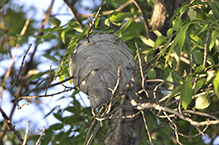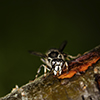Bald-faced hornet
(Dolichovespula maculata)
Conservation • Description • Habitat • Ecology • Distribution • Taxonomy
Conservation Status |
|||
| IUCN Red List | not listed |
||
| NatureServe | NNR - Unranked |
||
| Minnesota | not listed |
||
Description
Black with white markings on the head, the thorax, the last few segments of the abdomen, and first antennal segment. Wings smokey.
The nest is made of a gray-tan wood pulp and is in the shape of an inverted tear drop with an opening near the bottom. It is often found hanging high in a tree, but may be in a bush or other protected place.
Size
Similar Species
Habitat
Forest edges
Ecology
Season
Spring to late fall
Behavior
Life Cycle
Larva Food/Hosts
Pre-chewed insects
Adult Food
Flower nectar, fruit, and possibly other insects
Distribution |
||
|
Sources Biodiversity occurrence data published by: Minnesota Biodiversity Atlas (accessed through the Minnesota Biodiversity Atlas Portal, bellatlas.umn.edu, 6/4/2025). |
|
| 6/24/2025 | ||
Occurrence |
||
Common |
||
Taxonomy
Order
Hymenoptera (Ants, Bees, Wasps, and Sawflies)
Suborder
Apocrita (Narrow-waisted Wasps, Ants, and Bees)
Infraorder
Aculeata (ants, bees, and stinging wasps)
Superfamily
vespoidea (vespoid wasps)
Family
vespidae (hornets, paper wasps, potter wasps, and allies)
Subfamily
vespinae (hornets and yellowjackets)
Genus
Dolichovespula (aerial yellowjackets)
Subordinate Taxa
Synonyms
vespula maculata
Common Names
bald-faced aerial yellowjacket
bald-faced hornet
baldfaced hornet
What’s in a Name?
Though commonly called a hornet, this is actually a yellowjacket.
Visitor Photos
Share your photo of this insect.
This button not working for you?
Simply email us at info@MinnesotaSeasons.com.
Attach one or more photos and, if you like, a caption.
Bobbi Johnson |
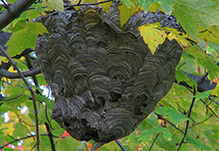 |
Luciearl |
||
 |
 |
|
 |
 |
|
Lisa R. |
||
Was stuck/dead in the oriole jelly feeder. |
||
 |
||
MinnesotaManda16 |
||
was sitting on my pool deck having a smoke @ 10:30pm last night, heard a really loud buzzing, assumed it was a junebug (not a fan of those at all either) and it flew and smacked me on my left lower leg. Freaked out I started stomping on it, killed it and realized it was a bald faced hornet. Confused why it was even out at night honestly. |
||
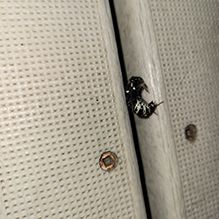 |
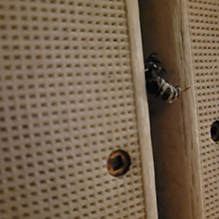 |
|
Alfredo Colon |
||
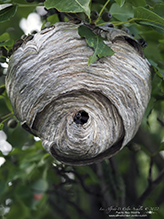 |
||
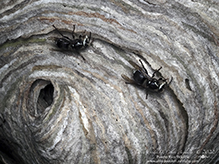 |
 |
|
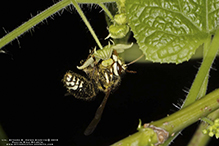 |
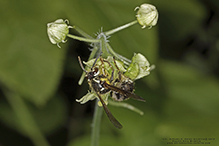 |
|
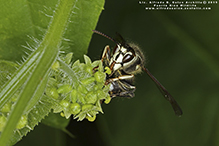 |
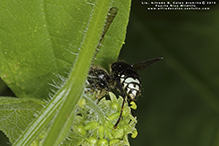 |
|
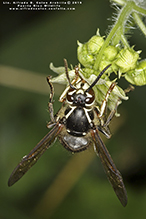 |
 |
|
Babette Kis |
||
Dolichovespula maculata bald-faced hornet I was out today at Barnes Prairie, and got a few pictures of this handsome aerial yellowjacket. Dolichovespula maculata, bald-faced hornet, on rigid goldenrod Oligoneuron rigidum, formerly known as Solidago rigida, Barnes Prairie, Racine Co., WI October 11, 2022. |
||
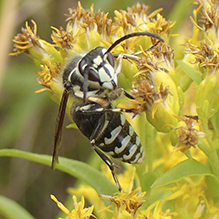 |
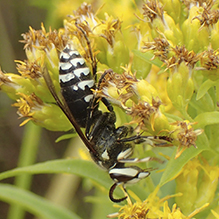 |
|
 |
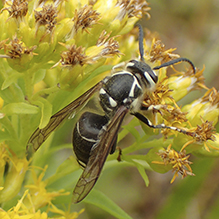 |
|
Kirk Nelson |
||
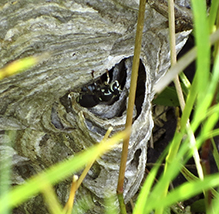 |
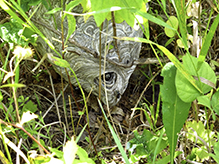 |
|
 |
 |
|
|
In this photo, a hornet is sitting just inside the entrance |
|
Guinness |
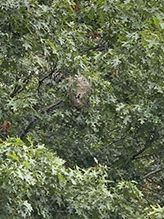 |
I have never seen this hornet around the area before. I have been here 18 years. I found the nest after researching a dead hornet by the door light at night. Have seen them mostly at dark by the door light. |
Judy |
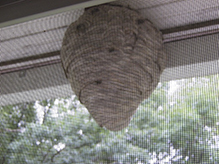 |
It is attached to the underside of the gutter on the house - I can watch them work from the upstairs window! I would like to find someone to claim the nest this fall, since it is quite beautiful! |
A.E. |
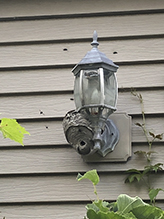 |
First time in my 20+ years here that I’ve seen these. |
Sandy A. |
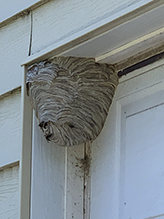 |
Large, beautiful and scary nest found in the corner of our garage door. |
Scott Bemman |
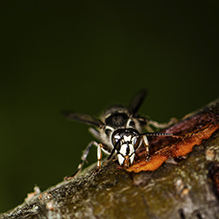 |
Chuck Ward |
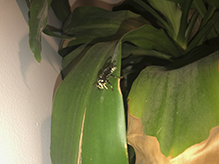 |
Norm & Peg Dibble |
||
 |
||
Is this a Bald Faced Hornet? I sure think they are fancy. We get a bunch of them every summer on our large Swamp Milkweed as shown in photo. I haven’t been afraid of them because they always fly away from me and are very concentrated on the blossoms. Should I avoid being near them? |
Hornet nest in our large Ash tree last summer |
|
MinnesotaSeasons.com Photos
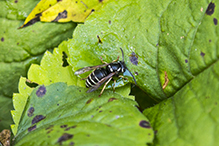 |
||
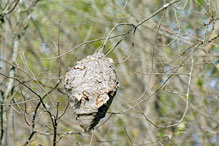 |
 |
|
 |
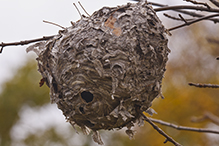 |

Slideshows
Bald Faced Hornet
DianesDigitals
Bald-faced Hornet (Dolichovespula maculata)
Andree Reno Sanborn

Visitor Videos
Share your video of this insect.
This button not working for you?
Simply email us at info@MinnesotaSeasons.com.
Attach a video, a YouTube link, or a cloud storage link.
Other Videos
Bald-faced Hornet (vespidae: Dolichovespula maculata) Queen, Close-up
Carl Barrentine
The Bald-Faced Hornet (Dolichovespula maculata)
FormiCanada
Bald Faced Hornet Dolichovespula maculata (Week 2)
AntsNational
Bald faced Hornet
PeppyShrimp1138
Bald-faced Hornet - Dolichovespula maculata
wetvideocamera

Visitor Sightings
Report a sighting of this insect.
This button not working for you?
Simply email us at info@MinnesotaSeasons.com.
Be sure to include a location.
Sarah
7/29/2025
Location: south Minneapolis
nest in maple tree in back yard - called pest control to come remove
Steph S
9/17/2024
Location: Burnsville Mn
these are all over my hummingbird feeder. And my neighbors feeder.
Anonymous
6/19/2024
Location: Minneapolis, Hiawatha Park
on begonias
MinnesotaManda16
6/11/2024
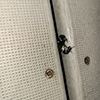
Location: Lonsdale, MN (Rice County)
was sitting on my pool deck having a smoke @ 10:30pm last night, heard a really loud buzzing,assumed it was a junebug (not a fan of those at all either) and it flew and smacked me on my left lower leg. Freaked out I started stomping on it, killed it and realized it was a bald faced hornet. Confused why it was even out at night honestly.
the Hiker
7/31/2023
Location: shoreline nest in waste high weeds Henderson MN.
I encountered this hornet hiking along a rivers shoreline in Henderson MN. This is the most aggressive hornet I've ever encountered.
Cindy
6/16/2023
Location: Little Falls, MN. Under the barn eve.
Big and nasty! Went out of there way to chase and sting me.
Babette Kis
10/11/2022

Location: Barnes Prairie, Racine Co., WI
I was out today at Barnes Prairie, and got a few pictures of this handsome aerial yellowjacket.
Dolichovespula maculata, bald-faced hornet, on rigid goldenrod Oligoneuron rigidum, formerly known as Solidago rigida, Barnes Prairie, Racine Co., WI October 11, 2022.
Deb
7/25/2022
Location: Dassel Mn
Marcia A Hoffman
8/24/2021
Location: Blaine
lived in Blaine 21 years and first one I’ve ever seen.
vB
7/25/2021
Location: Blackduck MN
They are all around the yard this year. So far we haven't spotted the best or nests
Guinness
9/12/2020
Judy
8/28/2020
Sandy A.
7/28/2020
vB
7/22/2020
Location: Chaska, Minnesota
at Hummingbird feeder
Tollef
7/15/2020
Location: Elizabeth Township, Ottertail County.
have never seen this type before. Small neat under a hose reel.
Becky Johnson
6/23/2020
Location: Shevlin, MN
Have nest on the outside of the house and under the wishing well.
Carol A Amundson
8/20/2019
Location: Scandia
Never noticed them before here on the Washington/Chisago county line. Many seen daily in calf yard chasin flies. We've had 2 bad stings.
Norm & Peg Dibble
7/15/2019

Location: Maple Grove, MN
Is this a Bald Faced Hornet? I sure think they are fancy. We get a bunch of them every summer on our large Swamp Milkweed as shown in photo. I haven’t been afraid of them because they always fly away from me and are very concentrated on the blossoms. Should I avoid being near them?
Norm & Peg Dibble
Summer 2018
Lisa
7/17/2018
Location: Shafer, MN
currently building a nest on my house.
MinnesotaSeasons.com Sightings



